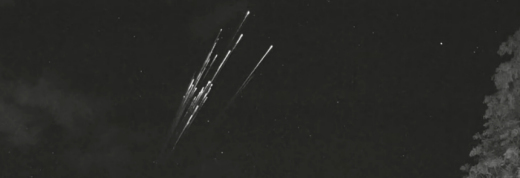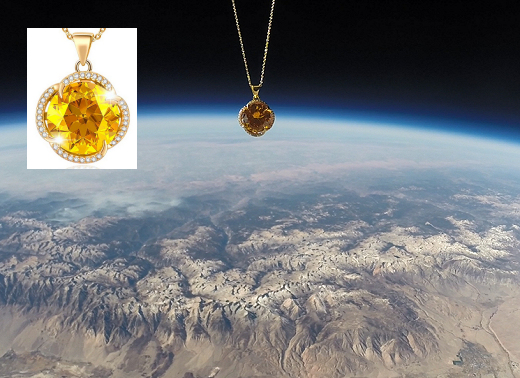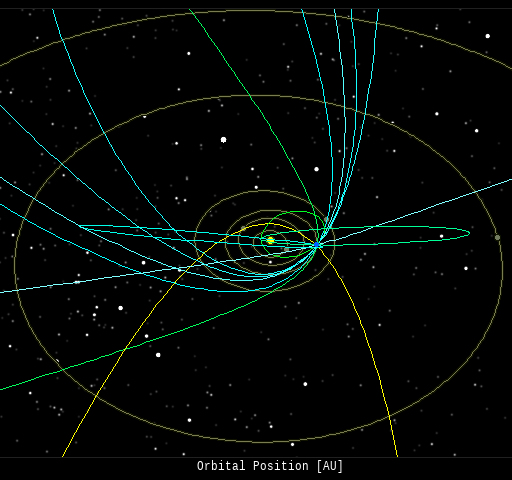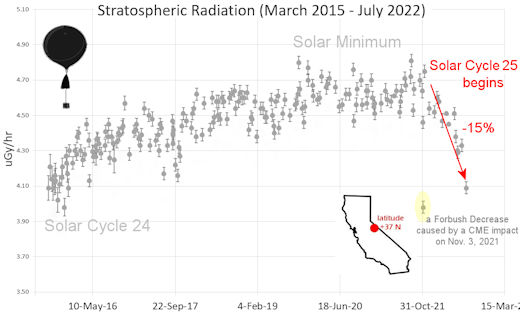Never miss another geomagnetic storm. Sign up for Space Weather Alerts and you'll receive a text message when magnetic storms erupt. Aurora tour guides and professional astronomers use this service. You can, too! | | |
WE ALMOST HAD AN X-FLARE TODAY: Departing sunspot AR3098 erupted today, Sept. 16th at 0949 UT, producing an impulsive M8-class solar flare: image. It was nearly an X-flare, the most powerful kind. A pulse of X-rays and extreme UV radiation caused a strong shortwave radio blackout over Africa and the Middle East. Ham radio operators in the area may have noticed unusual propagation conditions at frequencies below 25 MHz for as much as an hour after the flare. Solar flare alerts: SMS Text.
THE STARLINK INCIDENT: A minor geomagnetic storm is supposed to be minor. That's why even experts were surprised on Feb. 4, 2022, when dozens of Starlink satellites started falling out of the sky. A weak CME had hit Earth's magnetic field, and the resulting G1-class (minor) storm was bringing them down:

Above: A Starlink satellite breaks up over Puerto Rico on Feb. 7, 2022. Credit: The Sociedad de Astronomia del Caribe
How could this happen? A new paper published in the research journal Space Weather provides the answer.
"Although it was only 'minor,' the storm pumped almost 1200 gigawatts of energy into Earth's atmosphere," explains lead author Tong Dang of the University of Science and Technology of China. "This extra energy heated Earth's upper atmosphere and sharply increased aerodynamic drag on the satellites."
SpaceX launched the satellites from Cape Canaveral on Feb. 3, 2022. Forty-nine (49) Starlinks were crowded inside the Falcon 9 rocket; less than a quarter would survive.

Above: The Starlink launch was sandwiched between two minor geomagnetic storms (right) possibly caused by an Earth-directed CME that left the sun on Jan. 30th (left)
As was SpaceX's practice at the time, the satellites were deployed at an altitude of 210 km--their first stop en route to an operational altitude near 600 km. In the satellite business, 210 km is considered to be low, barely above the atmosphere. SpaceX starts there in case any satellite malfunctions after launch. From 210 km, a "bad sat" can be easily de-orbited.
A little too easily, as it turns out.
Using a physics-based computer model named "TIEGCM," Dang and colleagues simulated conditions during the storm. As geomagnetic energy heated Earth's atmosphere, the air density at 210 km increased globally by 20% with "hot spots" as high as 60%. This movie shows what happened:
Starlink dodged the worst spots. "The satellites did not hit any of the 60% regions," says Dang. "But that didn't save them." The weaker 20% enhancements were enough to bring down 38 out of 49 satellites.
To prevent a repeat, SpaceX has started launching to 320 km instead of 210 km. Earth's atmosphere has to reach that much higher to drag the satellites back during a geomagnetic storm. Since the change, more than 1200 additional Starlink satellites have been launched on 24 rockets without incident.
There's still danger, though. "Air density at 320 km is an order of magnitude less (compared to 210 km), but it's not completely safe," cautions Dang's co-author Jiuhou Lei, also from the University of Science and Technology of China. "During an extreme geomagnetic storm, density could increase from 200% to 800% even at these higher altitudes."
Extreme storms may be in the offing. Young Solar Cycle 25 is just getting started. The profusion of minor storms we are observing today will intensify in the years ahead especially as we approach Solar Max around 2025.
Elon Musk's note to self: Check the space weather forecast.
Realtime Space Weather Photo Gallery
Free: Spaceweather.com Newsletter
THE SUNBURST X-PENDANT: It's the color of a sunburst: The Citrine X-Pendant. The students of Earth to Sky Calculus launched this one to the stratosphere onboard an cosmic ray research balloon. At the apex of the flight it floated 120,892 feet above Earth's surface--a record high for our 10-year ballooning program:

You can have it for $199.95. The citrine gemstone is framed in a 18K gold-plated swirl with a matching 16-inch chain. The students are selling these pendants to support their cosmic ray ballooning program. Each one comes with a greeting card showing the necklace in flight and telling the story of its journey to the edge of space.
Far Out Gifts: Earth to Sky Store
All sales support hands-on STEM education
Realtime Aurora Photo Gallery
Free: Spaceweather.com Newsletter
Every night, a network of
NASA all-sky cameras scans the skies above the United States for meteoritic fireballs. Automated software maintained by NASA's Meteoroid Environment Office calculates their orbits, velocity, penetration depth in Earth's atmosphere and many other characteristics. Daily results are presented here on Spaceweather.com.
On Sep 15, 2022, the network reported 10 fireballs.
(8 sporadics, 2 Sept. epsilon Perseids)

In this diagram of the inner solar system, all of the fireball orbits intersect at a single point--Earth. The orbits are color-coded by velocity, from slow (red) to fast (blue). [Larger image] [movies]
Potentially Hazardous Asteroids (
PHAs) are space rocks larger than approximately 100m that can come closer to Earth than 0.05 AU. None of the known PHAs is on a collision course with our planet, although astronomers are finding
new ones all the time.
On September 16, 2022 there were 2293 potentially hazardous asteroids.
 |
Recent & Upcoming Earth-asteroid encounters: | Asteroid | Date(UT) | Miss Distance | Velocity (km/s) | Diameter (m) |
| 2022 QF2 | 2022-Sep-11 | 19.1 LD | 8.4 | 44 |
| 2022 RE | 2022-Sep-11 | 6 LD | 12.2 | 23 |
| 2022 RJ2 | 2022-Sep-12 | 3 LD | 15.9 | 14 |
| 2008 RW | 2022-Sep-12 | 17.5 LD | 10.2 | 98 |
| 2022 RQ | 2022-Sep-13 | 9.8 LD | 13.8 | 27 |
| 2020 UR1 | 2022-Sep-14 | 19.7 LD | 6.2 | 27 |
| 2022 RJ1 | 2022-Sep-15 | 19.7 LD | 3.3 | 18 |
| 2020 PT4 | 2022-Sep-15 | 18.8 LD | 10.8 | 39 |
| 2022 QD1 | 2022-Sep-16 | 19.5 LD | 9.5 | 80 |
| 2005 RX3 | 2022-Sep-18 | 12.4 LD | 17.5 | 123 |
| 2022 QB37 | 2022-Sep-18 | 17.2 LD | 9.2 | 59 |
| 2022 QJ50 | 2022-Sep-19 | 11 LD | 10.2 | 34 |
| 2022 QH8 | 2022-Sep-22 | 10.6 LD | 15.3 | 53 |
| 2022 QK36 | 2022-Sep-23 | 18.7 LD | 3.7 | 22 |
| 2022 RM | 2022-Sep-25 | 14.2 LD | 10 | 31 |
| 2016 HF2 | 2022-Sep-29 | 19.2 LD | 5.6 | 21 |
| 2018 ER1 | 2022-Oct-02 | 14.7 LD | 4 | 27 |
| 2018 VG | 2022-Oct-05 | 18.5 LD | 6.7 | 12 |
| 2021 TJ10 | 2022-Oct-06 | 19.6 LD | 8.1 | 6 |
| 2006 SG7 | 2022-Oct-07 | 16.7 LD | 18.4 | 93 |
| 2013 TJ6 | 2022-Oct-07 | 11.7 LD | 14.4 | 32 |
| 2013 SL20 | 2022-Oct-14 | 6.2 LD | 12.1 | 45 |
| 2020 TO2 | 2022-Oct-15 | 1.4 LD | 12.6 | 18 |
| 2020 BD | 2022-Oct-16 | 12.1 LD | 11.4 | 20 |
| 2022 QM6 | 2022-Oct-17 | 19.8 LD | 4.2 | 69 |
| 2016 TH94 | 2022-Oct-25 | 19.1 LD | 13.5 | 43 |
| 2019 AN5 | 2022-Oct-27 | 20 LD | 6.8 | 213 |
| 2004 UT1 | 2022-Oct-29 | 4 LD | 6.3 | 17 |
| 2021 VH | 2022-Nov-01 | 5.9 LD | 5.3 | 4 |
| 2022 RM4 | 2022-Nov-01 | 6 LD | 23.5 | 462 |
| 2020 WD | 2022-Nov-08 | 3 LD | 6 | 8 |
| 2019 XS | 2022-Nov-10 | 16.7 LD | 11.9 | 60 |
Notes: LD means "Lunar Distance." 1 LD = 384,401 km, the distance between Earth and the Moon. 1 LD also equals 0.00256 AU. | | Cosmic Rays in the Atmosphere |
SPACE WEATHER BALLOON DATA: Almost once a week, Spaceweather.com and the students of Earth to Sky Calculus fly space weather balloons to the stratosphere over California. These balloons are equipped with sensors that detect secondary cosmic rays, a form of radiation from space that can penetrate all the way down to Earth's surface. Our monitoring program has been underway without interruption for 7 years, resulting in a unique dataset of in situ atmospheric measurements.
Latest results (July 2022): Atmospheric radiation is decreasing in 2022. Our latest measurements in July 2022 registered a 6-year low:

What's going on? Ironically, the radiation drop is caused by increasing solar activity. Solar Cycle 25 has roared to life faster than forecasters expected. The sun's strengthening and increasingly tangled magnetic field repels cosmic rays from deep space. In addition, solar coronal mass ejections (CMEs) sweep aside cosmic rays, causing sharp reductions called "Forbush Decreases." The two effects blend together to bring daily radiation levels down.
.Who cares? Cosmic rays are a surprisingly "down to Earth" form of space weather. They can alter the chemistry of the atmosphere, trigger lightning, and penetrate commercial airplanes. According to a study from the Harvard T.H. Chan school of public health, crews of aircraft have higher rates of cancer than the general population. The researchers listed cosmic rays, irregular sleep habits, and chemical contaminants as leading risk factors. A number of controversial studies (#1, #2, #3, #4) go even further, linking cosmic rays with cardiac arrhythmias and sudden cardiac death.
Technical notes: The radiation sensors onboard our helium balloons detect X-rays and gamma-rays in the energy range 10 keV to 20 MeV. These energies span the range of medical X-ray machines and airport security scanners.
Data points in the graph labeled "Stratospheric Radiation" correspond to the peak of the Regener-Pfotzer maximum, which lies about 67,000 feet above central California. When cosmic rays crash into Earth's atmosphere, they produce a spray of secondary particles that is most intense at the entrance to the stratosphere. Physicists Eric Regener and Georg Pfotzer discovered the maximum using balloons in the 1930s and it is what we are measuring today.
| | The official U.S. government space weather bureau |
| | The first place to look for information about sundogs, pillars, rainbows and related phenomena. |
| | Researchers call it a "Hubble for the sun." SDO is the most advanced solar observatory ever. |
| | 3D views of the sun from NASA's Solar and Terrestrial Relations Observatory |
| | Realtime and archival images of the Sun from SOHO. |
| | information about sunspots based on the latest NOAA/USAF Active Region Summary |
| | current counts of failed and deployed Starlink satellites from Jonathan's Space Page |
| | Authoritative predictions of space junk and satellite re-entries |
| | from the NOAA Space Environment Center |
| | fun to read, but should be taken with a grain of salt! Forecasts looking ahead more than a few days are often wrong. |
| | from the NOAA Space Environment Center |
| | the underlying science of space weather |
 | BestCSGOGambling is the best site for everything related to CSGO gambling on the web |
 | To find reviews of new online casino sites in the UK try The Casino DB where there are hundreds of online casino reviews complete with bonuses and ratings. Alternatively, Online-Casinos.xyz is another massive directory of online casinos listing sites for the UK and Worldwide. Casinos that offer Rupees for bonuses are very generous to Indian players. Find the best online casinos in India at AllCasinos.in Looking for a new online casino? Try Casimpo the new site dedicated to making online casino simple, or check out the new Avenger Slots Casino and Ace Online Casino with over 500 online slots and casino games. |
 | One of the most popular casino games is the Book Of Dead Slot based on ancient Egyptian text, you can find all the casinos with spins at bookofdeadslotsites.com. |
 | When looking for casinos to play online when the weather is bad, you can try casino online trucchi for Italian games. If you are not from Finland you can try the Swedish page Svenska casino online to find suitable games, check out svenskacasinoonline.net. Always check your local laws before playing with real money. |
 | Looking for sports betting companies not registered on GamStop? CasinoGap has presented a list of sites not on GamStop available for UK players. Check and bet online! Would you like to bet at sites not using GamStop? Look at a list of NonStopCasino sites for online betting that aren't on GamStop. Top-rated bookmakers ever! |
| | These links help Spaceweather.com stay online. Thank you to our supporters! |
| | | | | | |

